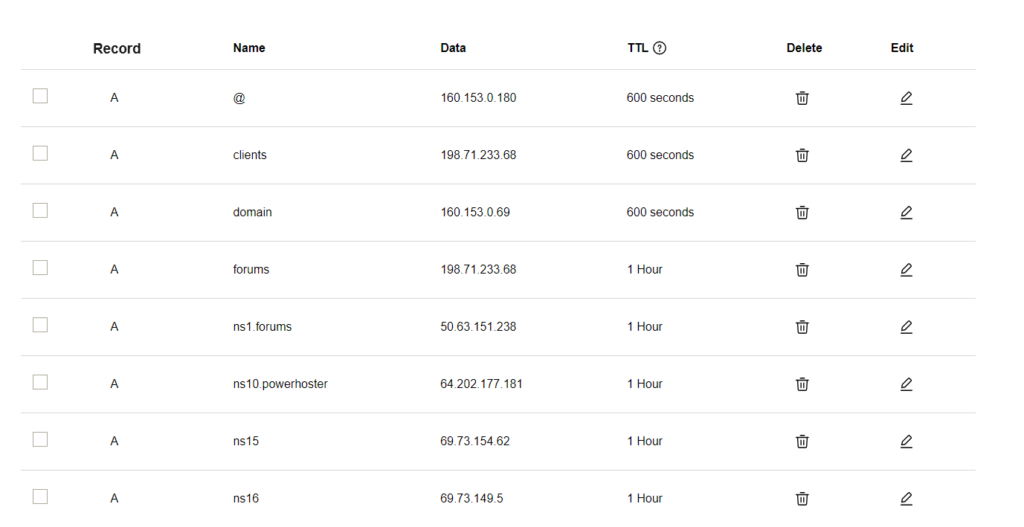A DNS A record, also known as an Address record, is a type of DNS (Domain Name System) record used to map a domain or subdomain to an IPv4 address. The “A” in A record stands for “Address.” This record is essential for translating human-readable domain names into machine-readable IP addresses, allowing computers to locate and connect to web servers.
The “A” stands for “address” and this is the most fundamental type of DNS record: it indicates the IP address of a given domain.
Here’s how the DNS A record works:
- Domain Name Resolution:
- When a user enters a domain name into a web browser or any other network application, the DNS resolution process begins.
- Querying DNS Servers:
- The DNS resolver, which is a part of the user’s device or the network, sends a query to DNS servers to obtain the IP address associated with the requested domain.
- A Record Lookup:
- If an A record exists for the domain, the DNS resolver receives the IPv4 address associated with that domain.
- IP Address Retrieval:
- The DNS A record provides a direct mapping between the domain and its corresponding IPv4 address. This IPv4 address is then used by the device to establish a connection to the web server hosting the requested content.
The syntax for a DNS A record is straightforward. It typically looks like this:
example.com. IN A 192.168.1.1
example.com: The domain or subdomain for which the A record is created.IN: Stands for Internet and specifies the class of the record.A: Indicates that this is an A record.192.168.1.1: The IPv4 address to which the domain or subdomain is mapped.
It’s important to note that with the increasing adoption of IPv6, another type of DNS record called AAAA (Quad-A) record is used to map domains to IPv6 addresses. Both A and AAAA records play a critical role in the DNS system, facilitating the translation of domain names to IP addresses for efficient network communication.
A records only hold IPv4 addresses. If a website has an IPv6 address, it will instead use an “AAAA” record.
Here is an example of an A record:
| example.com | record type: | value: | TTL |
|---|---|---|---|
| @ | A | 192.0.2.1 | 14400 |
The “@” symbol in this example indicates that this is a record for the root domain, and the “14400” value is the TTL (time to live), listed in seconds. The default TTL for A records is 14,400 seconds. This means that if an A record gets updated, it takes 240 minutes (14,400 seconds) to take effect.
The vast majority of websites only have one A record, but it is possible to have several. Some higher profile websites will have several different A records as part of a technique called round robin load balancing, which can distribute request traffic to one of several IP addresses, each hosting identical content.

When are DNS A Records Used?
DNS A records are used when there is a need to map a domain name or subdomain to an IPv4 address. These records play a crucial role in the Domain Name System (DNS) by providing a direct association between a human-readable domain name and the corresponding machine-readable IPv4 address. Here are common scenarios when DNS A records are used:
- Website Hosting:
- The primary use of DNS A records is to point a domain or subdomain to the IP address of the web server hosting the website. When someone enters a domain name in a web browser, the browser uses DNS to resolve the domain to the associated IP address. The A record provides the mapping for this purpose.
- Mail Servers (Mail Exchanger – MX Records):
- While MX (Mail Exchanger) records are specifically designed for handling email routing, they often reference A records. The A record is used to associate the domain’s mail server hostname with its IP address.
- Remote Access (VPN, Remote Desktop):
- In cases where remote access services are provided through a specific hostname (e.g., vpn.example.com or remote.example.com), DNS A records are used to link the hostname to the corresponding IP address of the remote access server.
- FTP Servers:
- FTP (File Transfer Protocol) servers may have DNS A records associated with their hostnames, allowing users to connect to the server by entering the hostname in FTP clients.
- Game Servers:
- Online multiplayer games often use DNS A records to map game server hostnames to their respective IP addresses, enabling players to connect to the correct server.
- Custom Applications and Services:
- Custom applications and services hosted on specific servers may have DNS A records to ensure that users and other systems can locate and connect to them using their assigned domain names.
- Load Balancers:
- In scenarios where websites or applications are distributed across multiple servers for load balancing and redundancy, DNS A records can point to the IP addresses of the load balancers, which then distribute incoming traffic to the backend servers.
- API Endpoints:
- APIs (Application Programming Interfaces) and other web services often have DNS A records associated with their domain names to direct client applications to the correct server for accessing the API endpoints.
In summary, DNS A records are used whenever there is a need to associate a domain or subdomain with a specific IPv4 address, enabling clients and applications to locate and connect to the corresponding server or service on the internet.